2019年中考英语语法复习方案13--特殊句式
- 格式:doc
- 大小:76.50 KB
- 文档页数:8

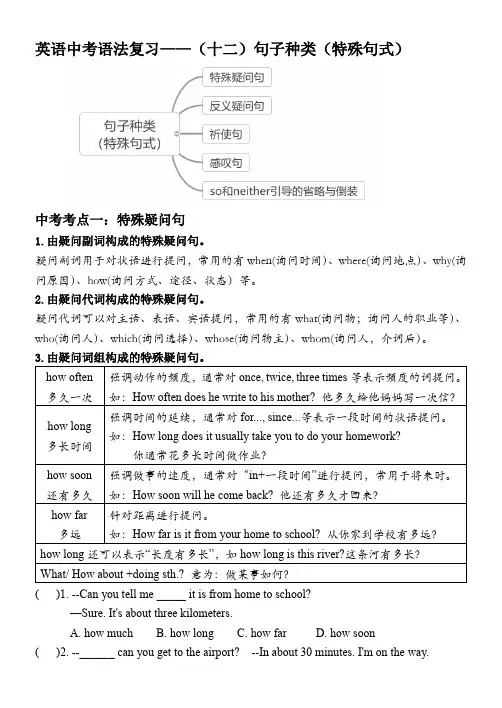
英语中考语法复习——(十二)句子种类(特殊句式)中考考点一:特殊疑问句1.由疑问副词构成的特殊疑问句。
疑问副词用于对状语进行提问,常用的有when(询问时间)、where(询问地点)、why(询问原因)、how(询问方式、途径、状态)等。
2.由疑问代词构成的特殊疑问句。
疑问代词可以对主语、表语、宾语提问,常用的有what(询问物;询问人的职业等)、who(询问人)、which(询问选择)、whose(询问物主)、whom(询问人,介词后)。
how often 多久一次强调动作的频度,通常对once, twice, three times等表示频度的词提问。
如:How often does he write to his mother? 他多久给他妈妈写一次信?how long 多长时间强调时间的延续,通常对for..., since...等表示一段时间的状语提问。
如:How long does it usually take you to do your homework?你通常花多长时间做作业?how soon 还有多久强调做事的速度,通常对“in+一段时间”进行提问,常用于将来时。
如:How soon will he come back? 他还有多久才回来?how far 多远针对距离进行提问。
如:How far is it from your home to school? 从你家到学校有多远?how long还可以表示“长度有多长”,如how long is this river?这条河有多长?What/ How about +doing sth.? 意为:做某事如何?( )1. --Can you tell me _____ it is from home to school?—Sure. It's about three kilometers.A. how muchB. how longC. how farD. how soon( )2. --______ can you get to the airport? --In about 30 minutes. I'm on the way.A. How soonB. How longC. How muchD. How often( )3. --______ have you worked here? —For just one month.A. How oftenB. How longC. How soonD. How much( )4. --We don't have much homework this weekend. Shall we go out together?—OK. What about_______A. to see B seeing C. to see D. sees中考考点二:反义疑问句A. 反义疑问句的标准形式反义疑问句的标准形式是。


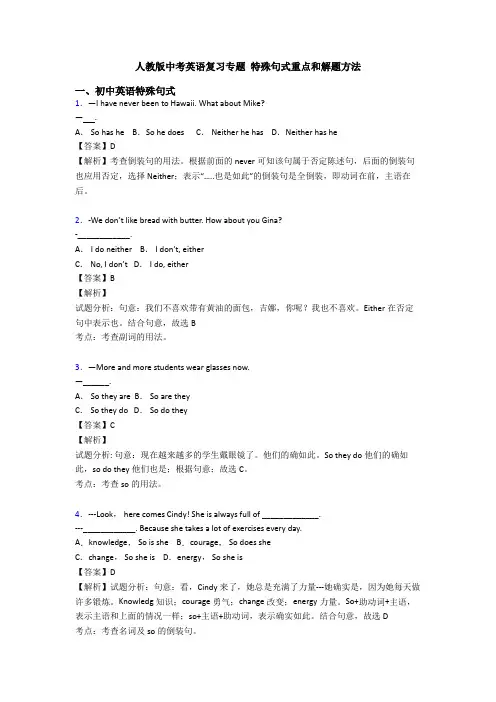
人教版中考英语复习专题特殊句式重点和解题方法一、初中英语特殊句式1.—I have never been to Hawaii. What about Mike?— .A. So has he B.So he does C. Neither he has D.Neither has he【答案】D【解析】考查倒装句的用法。
根据前面的never可知该句属于否定陈述句,后面的倒装句也应用否定,选择Neither;表示“…..也是如此”的倒装句是全倒装,即动词在前,主语在后。
2.-We don’t like bread with butter. How about you Gina?-____________.A. I do neither B.I don’t, eitherC.No, I don’t D. I do, either【答案】B【解析】试题分析:句意:我们不喜欢带有黄油的面包,吉娜,你呢?我也不喜欢。
Either在否定句中表示也。
结合句意,故选B考点:考查副词的用法。
3.—More and more students wear glasses now.—______.A. So they are B. So are theyC. So they do D. So do they【答案】C【解析】试题分析: 句意:现在越来越多的学生戴眼镜了。
他们的确如此。
So they do他们的确如此,so do they他们也是;根据句意;故选C。
考点:考查so的用法。
4.---Look, here comes Cindy! She is always full of _____________.---____________. Because she takes a lot of exercises every day.A.knowledge, So is she B.courage, So does sheC.change, So she is D.energy, So she is【答案】D【解析】试题分析:句意:看,Cindy来了,她总是充满了力量---她确实是,因为她每天做许多锻炼。
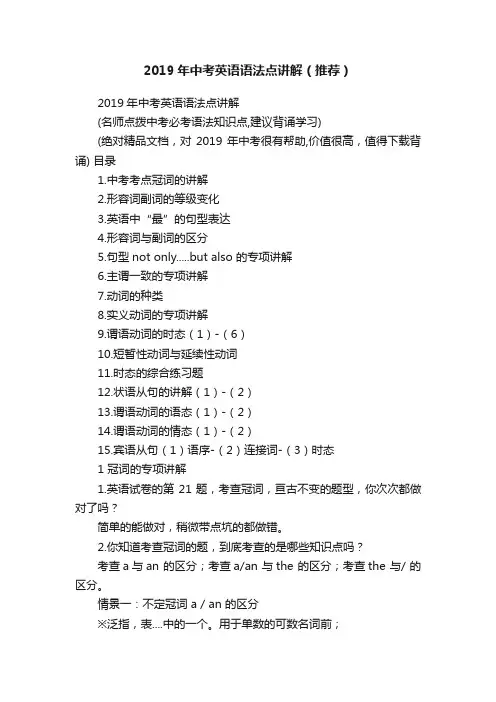
2019年中考英语语法点讲解(推荐)2019年中考英语语法点讲解(名师点拨中考必考语法知识点,建议背诵学习)(绝对精品文档,对2019年中考很有帮助,价值很高,值得下载背诵) 目录1.中考考点冠词的讲解2.形容词副词的等级变化3.英语中“最”的句型表达4.形容词与副词的区分5.句型not only.....but also 的专项讲解6.主谓一致的专项讲解7.动词的种类8.实义动词的专项讲解9.谓语动词的时态(1)-(6)10.短暂性动词与延续性动词11.时态的综合练习题12.状语从句的讲解(1)-(2)13.谓语动词的语态(1)-(2)14.谓语动词的情态(1)-(2)15.宾语从句(1)语序-(2)连接词-(3)时态1 冠词的专项讲解1.英语试卷的第21题,考查冠词,亘古不变的题型,你次次都做对了吗?简单的能做对,稍微带点坑的都做错。
2.你知道考查冠词的题,到底考查的是哪些知识点吗?考查a与an 的区分;考查a/an 与the 的区分;考查the 与/ 的区分。
情景一:不定冠词 a / an 的区分※泛指,表....中的一个。
用于单数的可数名词前;※a一般用于以辅音因素开始的词前;an 一般用于以元音音素开始的词前;1)26个字母前 a / an 的区分,I i /ai/ , L l /el/, an: A a /ei/, E e /i:/ , F f /ef/, H h /eit∫//, S s /es/,X x /eks/M m /em/,N n /en/,O o /?u/, R r /ɑ:(标红的均为元音因素) 共12个a: B b /bi:/, C c /si:/, D d /di:/,G g /d3i:/, J j /d3ei/ K k /kei/,P p /pi:/,Q q /kju:/ T t /ti:/,U u /ju:/ V v /vi:/ ,W w /′d?blju:/,Y y /wai/,Z z /zi:/,2) 数字前的区分an eight-year-old boy an eighteenth-meter-long river an eighty-word article an eleven-day holiday.3) 形容词前的词区分an: an interesting film; an exciting news; an important meeting; an unlucky day;.........a: a useful book; a European country; (这里的u和字母u 发音一样,故用a)4) 名词前的区分an : an hour ; an umbrella; an orange.......a : a university (这里的u和字母u 发音一样,故用a)情景二:不定冠词a/an与定冠词the的区分我们来看三道经典例题:例1. --What a heavy rain it was! (泛指:It was a heavy rain. 那是一场大雨。

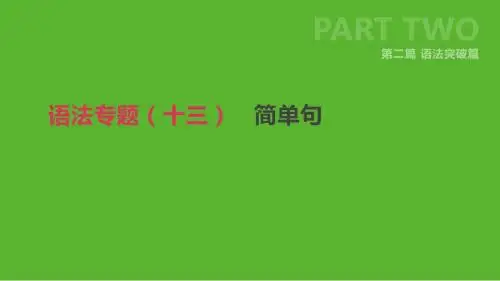
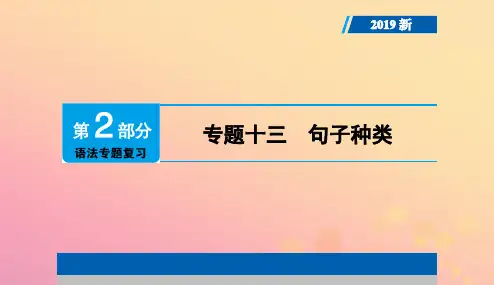
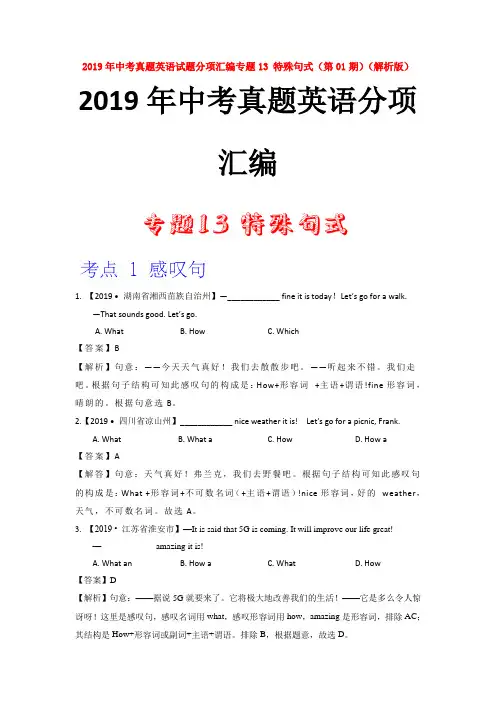
2019年中考真题英语试题分项汇编专题13 特殊句式(第01期)(解析版)2019年中考真题英语分项汇编1. 【2019 • 湖南省湘西苗族自治州】—____________ fine it is today!Let’s go for a walk.—That sounds good. Let’s go.A. WhatB. HowC. Which【答案】B【解析】句意:——今天天气真好!我们去散散步吧。
——听起来不错。
我们走吧。
根据句子结构可知此感叹句的构成是:How+形容词+主语+谓语!fine形容词,晴朗的。
根据句意选B。
2.【2019 • 四川省凉山州】____________ nice weather it is! Let’s go for a picnic, Frank.A. WhatB. What aC. HowD. How a【答案】A【解答】句意:天气真好!弗兰克,我们去野餐吧。
根据句子结构可知此感叹句的构成是:What +形容词+不可数名词(+主语+谓语)!nice形容词,好的weather,天气,不可数名词。
故选A。
3. 【2019 • 江苏省淮安市】—It is said that 5G is coming. It will improve our life great!—____________ amazing it is!A. What anB. How aC. WhatD. How【答案】D【解析】句意:——据说5G就要来了。
它将极大地改善我们的生活!——它是多么令人惊讶呀!这里是感叹句,感叹名词用what,感叹形容词用how,amazing是形容词,排除AC;其结构是How+形容词或副词+主语+谓语。
排除B,根据题意,故选D。
【点睛】由"how"引导的感叹句:"how"意为"多么",用作状语,修饰形容词或副词(被强调部分)。
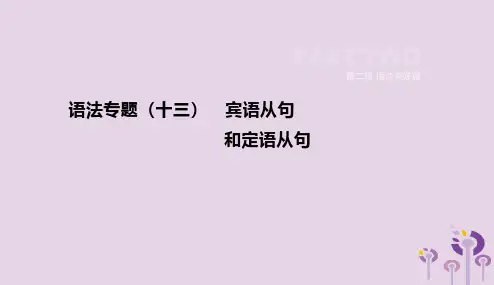
2019年中考英语语法复习方案13《特殊句式》【趋势解读】初中阶段特殊句式的考查主要是对感叹句、存在句、倒装句、反意疑问句、省略句的考查,考生需牢记与其相关的句型才能正确做题。
其中,倒装句与省略句的考查往往难度较大,是考生容易忽视与出错的知识点。
预计中考及自主招生关于本专题知识命题趋势如下:各地中考时态考查的热点为感叹句、存在句与反意疑问句。
而自主招生考试对这6类句式都有可能涉及,又主要考查反意疑问句的特殊结构、倒装句、强调句及省略句,对考生要求较高,分值为2~5分。
【思维引导】精彩笔记1 so, neither倒装句型倒装属于语法中语序的范畴。
自然语序基本是主语在前谓语在后,那么倒装语序是谓语在前,主语在后。
完全倒装即将谓语的全部(主要是指其实义动词)置于主语之前;部分倒装是指只将谓语的一部分(系动词、助动词和情态动词)置于主语之前,实义动词仍然保留在主语之后。
(1) Lucy is a good student, and so is Lily.露西是好学生,莉莉也是(好学生)。
“so+be/助动词/情态动词+主语”依附于肯定句,表示前边的肯定情况也适用于后边的人(或物),意为“……也……”。
(2) If you do not go swimming, neither shall I.如果你不去游泳,我也不去。
“neither+be/助动词/情态动词+主语”依附于否定句,表示前边的否定情况也适用于后边的人(或物),意为“……也不……”。
核心题根 1 (1)—I hear Yang Yan made an English speech at the graduation ceremony yesterday.—,and.A. So she did; so did IB. So did she; so I didC. So she was; so I wasD. So was she; so I was思路点拨:①句意:一我听说杨艳在昨天的毕业典礼上作了一场英语演讲。
一确实如此,而且我也演讲了。
根据题意,应该是前者表确认、肯定,意为“的确如此”,而后者意为“……也做了”。
②C, D是错误的选项,上句中“made”是实义动词,后面的倒装句的助动词要与其保持一致。
③“她确实如此”要用so she did,用来表达对前面情况的肯定、确认,不能倒装。
(2)—I haven't seen the film Pirates of the Caribbean: On Stranger Tides. 一.A. Neither have IB. So have IC. Neither I haveD. So I have思路点拨:句意:一我没有看过《加勒比海盗:惊涛怪浪》这部电影。
一我也没看过。
由题意可知这里是表示否定的回答,当用neither时,要用倒装句形式。
(3)—Maggie had a wonderful time at the party. 一,and so did I.A. So she hadB. So had sheC. So she didD. So did she思路点拨:句意:—Maggie在晚会上玩得很高兴。
一她确实玩得很高兴,我也玩得很高兴。
so引起的省略句,表示与前句肯定的内容呼应,与前面内容一致时,要用倒装结构,即“so+助动词(be/情态动词)+主语”。
本题答语中的and so did I就是这种结构。
而空白处是对前面所说话的确认、同意或肯定,因此不用倒装。
注意:“had”在题干中不是助动词。
易错警示“so/neither+助动词/be/情态动词+主语+谓语”句型中的“be/助动词/情态动词”在形式上必须与前句的谓语动词保持一致;而其单复数则由后面的主语决定。
同类变式1 (1)一I never drink coffee. 一.A. So do IB. So did IC. Neither did ID. Neither do I(2) —Tom, I'm watching a football match. What about you? 一.A. So do IB. So am IC. So I doD. So I am(3)—Well, I do think the rabbit is a beautiful, gentle animal which can run very fast. 一.A. So it isB. So is itC. So does itD. So it does易错警示so I do与so do I不同。
在“so I do”中so引起的省略句不作“也……”讲,只是对前面的情况表示确认、肯定,这时省略的主语和谓语不必倒装,意为“的确如此”。
如:一He has made great progress.他取得了很大进步。
—Yes, so he has.是的,他确实是(取得进步)。
And so have you.你也是(取得很大进步)。
精彩笔记2 there be句型there be句型是表示“存在”的一个句型,是一个主语在be动词后面的倒装句。
谓语动词除了be 还可以是表示状态的不及物动词,如seem, happen, live, stand, lie等。
Once upon a time, there lived a monk in the temple.从前这座庙里有个和尚。
核心题根2 There still some milk in the fridge. It's not necessary to go to the store today.A. amB. isC. areD. be思路点拨:考查there be句型。
句意:冰箱里还有一些牛奶,今天没有必要去商店。
milk是不可数名词,因此应该用is。
同类变式2 —any students in the classroom when the earthquake happened?一Yes, but they have been saved.A. There wereB. Was thereC. There areD. Were there精彩笔记3 以副词、介词短语开头的倒装句here, there, out, in, down, away等表示方位的副词或表示方位的介词短语置于句首且主语是名词时,要用倒装句。
而谓语动词的形式由位于倒装句句尾的主语决定。
如:Out rushed the children.孩子们冲出去了。
There comes a woman.那边过来了一位妇女。
In front of my house stands a tall tree.我的房子前面有棵大树。
核心题根3 (1) from the fifth floor when the policeman pointed his gun at him.A. Jumped down the muderer(凶犯)B. Down the murderer jumpedC. The murderer jumping downD. Down jumped the murderer思路点拨:句意:当警察用枪指着凶犯时,他从第五层楼跳下去了。
本题考查全部倒装。
down是表示方向的副词,在句首时,句子的谓语动词jumped要放在the murderer之前。
(2) At the meeting place of the Yangtze River(长江)and Dialing River ,one of the ten largest cities in China.A. lies ChongqingB. Chongqing liesC. does lies ChongqingD. does Chongqing lie思路点拨:句意:中国十大城市之一重庆位于长江和嘉陵江汇合之处。
Chongqing是主语,one of the ten...China是Chongqing的同位语,lies是谓语动词,at the meeting ... Dialing River是介词短语作地点状语。
一目了然,作地点状语的介词短语提前到句首,以使句子平衡或突出状语,谓语动词是be, stand, lie等。
这样的句子要全部倒装。
同类变式3 (1) Hey, Nick. comes the last bus! Hurry up,or we'll have to walk home.A. ThisB. ThereC. ThatD. It(2) Hearing the dog barking fiercely, away .A. fleeing the thiefB. was fleeing the thiefC. the thief was fleeingD. fled(flee的过去式)the thief(3)一Where is the report? 一.A. There it isB. There is itC. There the report isD. Is the report there易错警示如果主语不是名词,是人称代词,就不必倒装。
如:The door opened, in came a policeman.(主语是名词,倒装)The door opened, in he came.(主语是代词he,不倒装)知识归纳在表示方向的副词如down, up, in, out, over, back. off, away等作状语位于句首时,如果谓语动词是jump, come, go, rush等不及物动词,句子要全部倒装,即谓语动词全部放在主语前面。
精彩笔记4当句首的状语是only+副词,only+介词短语或状语从句时,主句要部分倒装。
即只把谓语的一部分(多为助动词或情态动词)置于主语前。
如:Only by practice can we improve our spoken English.只有通过练习,我们才能提高英语口语水平。
核心题根4 (1) Only when I left my parents for Italy how much I love them.A. I realizedB. I had realizedC. had I realizedD. did I realize思路点拨:句意:只有离开父母去意大利时,我才意识到我是多么爱他们。
Only后可接状语从句,还可接介词短语和副词,在这种结构中,主句应该部分倒装。
C项had I realized是过去完成时,表示realize这个动作发生在left之前,显然错误。